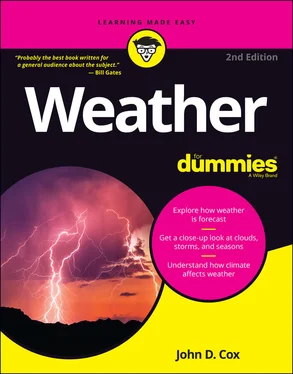Weather forecasting is such a complicated and difficult business because it is trying to predict the behavior of a system that has many features that are all changeable, all the time. Observations of every sort need to be gathered. How warm or how cold is it? Which way is the wind blowing? Is it cloudy, or is it clear? Details about all these features and more are gathered from every source available.
From the ground, these measurements come from human weather observers and from instruments on automatic weather stations. From the air, they come from weather balloons and airplanes and satellites orbiting the planet in space. From the sea, they come from ships and from instruments on anchored moorings and drifting buoys, as well as satellites. (See Chapter 16for more about these measurement tools.)
Every day, 24 hours a day, data from thousands and thousands of weather observations around the world is streaming electronically into National Weather Service computers and other major weather centers around the world. With these millions and millions of bits of data, the computers are constantly updating and refining their highly detailed descriptions of the current state of the weather — the nowcast.
When you think about it, meteorology is a funny word for weather science, isn’t it? A meteor is an object from space, usually a tiny bit of comet dust, that leaves a flash as it burns up in Earth’s upper atmosphere. What exactly does that have to do with weather? The answer is, exactly nothing!
But Aristotle, the great Greek philosopher, didn’t know all of this at the time he first used the word meteorology back around 350 B.C. Everything that happened above the Earth was considered astronomy in those days, and Aristotle was trying to define a new science. Astronomy was the study of all the stuff that goes on in the distant heavens, he figured, and meteorology was the study of the stuff that happens closer to Earth.
The Greek word meteoron means something that falls from the sky. (Hence, the phrase: “Don’t be such a meteoron.”) Anyway, what Aristotle had in mind, mostly, was weather, the study of rain and snow and hail. But he also threw in such things as comets and earthquakes. Go figure… .
Later, of course, comets were given back to astronomers, and earthquakes became part of the science of geology.
… And add a little future
Computer models, or software programs, of numerical weather prediction divide the atmosphere over the surface of the Earth and above it into imaginary individual blocks, or gridpoints. Different models use different techniques to force changes in their virtual atmospheres. Some are better at depicting the progress of one type of weather change, and some are better at others.
 Each of these separate blocks of air has features, such as temperature, pressure, wind, and humidity, with their own values. The computers take the data of all these values from all these blocks of air and apply a set of equations that represent basic physical laws. (No, I know you must be deeply disappointed, but the only equation you are going to find in this book is 1 Weather For Dummies = 0 equations.)
Each of these separate blocks of air has features, such as temperature, pressure, wind, and humidity, with their own values. The computers take the data of all these values from all these blocks of air and apply a set of equations that represent basic physical laws. (No, I know you must be deeply disappointed, but the only equation you are going to find in this book is 1 Weather For Dummies = 0 equations.)
Anyway, the output of this incredibly intensive process of computation produces a new value for each key weather feature at each gridpoint. But each complete computation moves the atmosphere forward into the future only a few minutes.
And so the whole process starts all over again. The computer begins analyzing the data in each block with the new values it has forecast, nudging the weather system forward a few minutes at a time until the desired length of weather forecast is achieved. The experts say that to produce a weather forecast of a few days, modern computer models may need to complete more than one trillion calculations (1,000,000,000,000). So just how super are these computers? Scientists figure they are about six million times more powerful than the average desktop computer.
The forecast method known as Numerical Weather Prediction has led to some pretty impressive improvements in recent years, but nobody expects computer models to make individual human forecasters obsolete anytime soon. Even with all that computing power, the numerical prediction models are not detailed enough for every weather forecasting purpose. For example, the models don’t very accurately account for the effects on weather of local landscape features such as mountains or lakes. And thunderstorms, which look pretty big when they’re coming at you, are too small and too short-lived even to show up on the big numerical models.
And another thing about all this computing power and these state-of-the-art weather forecasting models — did I mention that they are not always accurate?
The atmosphere has a physical characteristic, like a personality trait, that sometimes drives forecasters to distraction, especially as they try to predict what the weather is going to be like beyond a few days.
All disturbances in the atmosphere grow and decay. Some disturbances are big enough to be measured — and “seen” by computer models — and predicted. Other disturbances are too small. In such a chaotic system, very small disturbances can lead to big disturbances over time.
When he discovered this characteristic of weather in the early 1960s, meteorologist Edward Lorenz at the Massachusetts Institute of Technology came up with an interesting way to describe the problem. Imagine a butterfly in the jungles of the Amazon fluttering its wings and setting in motion a subtle whirl of breeze that travels and magnifies through the atmosphere over time. Farther and farther it goes, bigger and bigger it grows. Two weeks later, this breeze results in a tornado over Kansas. This is known as the Butterfly Effect.
Should the Butterfly Effect be taken literally? No. But forecasters ever since then have taken very seriously the big idea behind it. The atmosphere’s way of doing things is on a scale that is always going to be finer, or more exacting, than the scale for the data on initial conditions that goes into the numerical forecast models. This means that, no matter how much computer power is thrown into the job, it is simply not possible to create a 100 percent accurate forecast, or a detailed weather forecast beyond about two weeks.
“We interrupt this program …”
Besides the regularly scheduled daily forecasts, National Weather Service offices around the United States as well as private forecasters issue special weather statements and watches and warnings and advisories appropriate to local circumstances.
They are issued for such things as tornadoes, severe thunderstorms, floods, and winter storm conditions such as blizzards, heavy snow, ice storms or freezing rain, high winds, and dust storms.
When threats to public safety are imminent, bulletin warnings are issued — only by the National Weather Service — and a special communications network known as the Emergency Alert System is activated. When this happens, local radio and television broadcasters interrupt their regularly scheduled programs to pass them along. Every year, the National Weather Service issues between 45,000 and 50,000 severe weather warnings. Whatever the hazard, the differences between these various levels of public notices can be worth knowing.
A Special Weather Statement often is issued as a “first alert” to the possibility of significant weather. This kind of “heads up” also is issued when forecasters see the likelihood of such things as thunderstorms with small hail, which may not be life-threatening but could make conditions temporarily hazardous.
Читать дальше

 Each of these separate blocks of air has features, such as temperature, pressure, wind, and humidity, with their own values. The computers take the data of all these values from all these blocks of air and apply a set of equations that represent basic physical laws. (No, I know you must be deeply disappointed, but the only equation you are going to find in this book is 1 Weather For Dummies = 0 equations.)
Each of these separate blocks of air has features, such as temperature, pressure, wind, and humidity, with their own values. The computers take the data of all these values from all these blocks of air and apply a set of equations that represent basic physical laws. (No, I know you must be deeply disappointed, but the only equation you are going to find in this book is 1 Weather For Dummies = 0 equations.)










